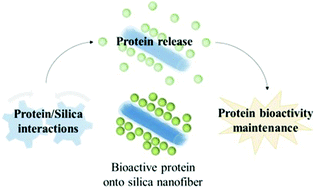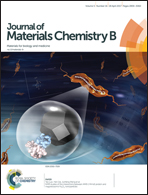Silica nanofibers as a new drug delivery system: a study of the protein–silica interactions
Abstract
Drug delivery systems are proposed for the in situ controlled delivery of therapeutic molecules in the scope of tissue engineering. We propose herein silica nanofibers as carriers for the loading and release of bioactive proteins. The influence of pH, time and concentration on the amount of adsorbed proteins was studied. The interactions allowing loading were then studied by means of electron microscopy, zeta potential measurements, electron energy loss spectroscopy and attenuated total reflectance Fourier transform infrared analysis. Release profiles were determined and biological activities were enzymatically assessed. The first part of the work was carried out with lysozyme as a model protein, and then bioactive growth factors TGF-β1 and GDF-5 were used because their significance in human adipose stromal cell differentiation towards intervertebral disc nucleopulpocytes was previously assessed. It is demonstrated that protein–silica nanofiber interactions are mainly driven by hydrogen bonds and local electrostatic interactions. The present data thus provide a better understanding of the adsorption phenomenon involved, as well as a method to control protein adsorption and release. It is worth pointing out that the kinetic release of growth factors, up to 28 days, and their biological activity maintenance seem to be compatible with intervertebral disc regenerative medicine.



 Please wait while we load your content...
Please wait while we load your content...